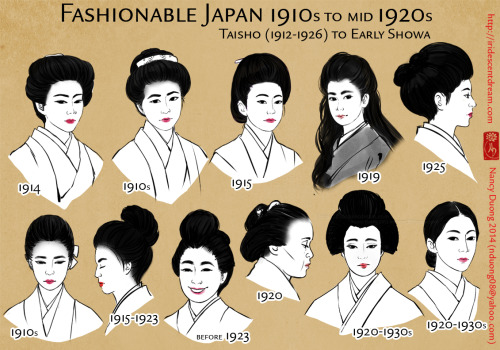nannaia:This is a hairstyle timeline that is meant to cover the Taishō era (1912-1926). However the
nannaia:This is a hairstyle timeline that is meant to cover the Taishō era (1912-1926). However the dates for many reference photographs were rather vague, so some might actually fall into Shōwa era (1926-1989). Regrettably I couldn’t cover EVERY single hairstyle from this period so please consider this to be a brief overview. There are no Geisha, Maiko, etc featured here; they will be covered in another fashion timeline someday.Some interesting notes about Meiji-Taisho era from Liza Crihfield Dalby’s Kimono: Fashioning Culture (1993)· “Men and women of Meiji had gulped up Western culture with all the indiscriminate enthusiasm of new converts. By Taishō, Japanese sensibilities vis-à-vis the West were much smoother. This was Japan’s political equivalent of the … social scene of the American Roaring Twenties. Japanese born during Taishō would enter adolescence as modern boys and girls. Significantly, women opened their closets to Western clothing during this decade. Kimono has lost space ever since.” (pg. 124)· “By 1915 Japan was beginning to feel itself a world-class nation, more confident of its military strength and social development. Ordinary Japanese were inclined to look at their society in light of how life might be bettered by adapting foreign ideas, or made more interesting by acquiring foreign fashions. Borrowing from the West was of course not new, but it had now become a more reciprocal and respectable process.” (pg. 124)WOMEN’s HAIR:· In the Meiji era “a few women cropped their hair, but these courageous souls were simply regarded as weird” and indecent (pg. 75)· “If cutting the hair short was too radical [in Meiji Japan], as public reaction attests, women’s hair did gain a new option in the sokugami style, a pompadour resembling the chignons worn by Charles Dana Gibson’s popular Gibson girls. The further the front section, or ‘eaves,’ of the hair protruded, the more daring the style. The sokugami style bunched the hair, coiling it in a bun at the crown of the head. Unlike traditional coiffures, sokugami did not require the heavy use of pomade, pins, bars, strings, and false hair to hold its shape. Its appeal was promoted as healthier and more rational – hence, more enlightened- than the old ways.” (pg. 75) -- source link
#wtfhistory#history#poc history#asian history#japanese history#fashion#womens history#clothes#clothing#fashion history#art history




